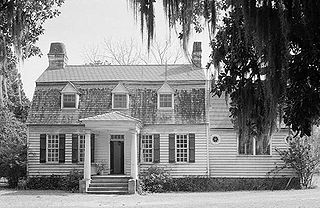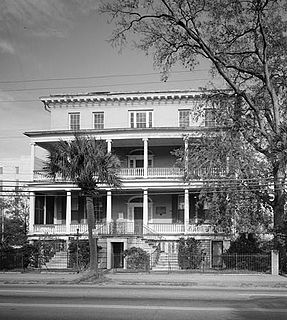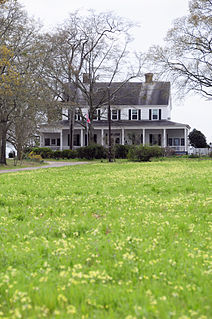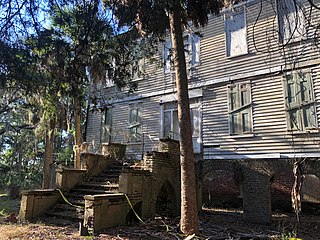
The Charles Pinckney National Historic Site is a unit of the United States National Park Service, preserving a portion of Charles Pinckney's Snee Farm plantation and country retreat. The site is located at 1254 Long Point Road, Mount Pleasant, South Carolina. Pinckney (1757-1824) was a member of a prominent political family in South Carolina. He fought in the American Revolutionary War, was held for a period as prisoner in the North, and returned to the state in 1783. Pinckney served as a delegate to the constitutional convention where he contributed to drafting the United States Constitution.

McLeod Plantation is a former slave plantation located on James Island, South Carolina, near the intersection of Folly and Maybank roads at Wappoo Creek, which flows into the Ashley River. The plantation is considered an important Gullah heritage site, preserved in recognition of its cultural and historical significance to African-American and European-American cultures.

Presqu'ile, or Presqui'ile,, the French term for "peninsula", was an appropriate name for the house built at 2 Amherst St., Charleston, South Carolina between 1802 and 1808 because, at the time, the house stood on a finger of high ground that projected into the marshes of the Cooper River. The builder, Jacob Belser, was a planter, attorney, and state senator (1812–15).

Hanover House is a colonial house built by a French Huguenot family in 1714–1716, on the upper Cooper River in present-day Berkeley County of the South Carolina Low Country. The house is also known as the St. Julien-Ravenel House after its early owners.

Hampton Plantation, also known as Hampton Plantation House and Hampton Plantation State Historic Site, is a historic plantation, now a state historic site, north of McClellanville, South Carolina. The plantation was established in 1735, and its main house exhibits one of the earliest known examples in the United States of a temple front in domestic architecture. It is also one of the state's finest examples of a wood frame Georgian plantation house. It was declared a National Historic Landmark in 1970.

Mulberry Plantation is a historic plantation property in rural Berkeley County, South Carolina. Located between Moncks Corner and Charleston, this property was developed in 1714 by Thomas Broughton, who became the Royal governor of South Carolina, and is one of the oldest plantation homes in the United States. Its rice fields, dikes and canals were well-preserved into the 20th century. The plantation house and ten surrounding acres were declared a National Historic Landmark in 1963.

The Robert William Roper House is an historic house at 9 East Battery in Charleston, South Carolina. It was built on land purchased in May 1838 by Robert W. Roper, a state legislator from the parish of St. Paul's and a prominent member of the South Carolina Agricultural Society, whose income derived from his position as a cotton planter and slave holder. The house is an outstanding example of early 19th Century Greek Revival architecture, built on a monumental scale. Although there are now two houses between Roper House and White Point Garden to the south, for a decade after its construction nothing stood between the house and the harbor beyond, making it the first and most prominent house to be seen by visitors approaching Charleston by sea.

The Gov. William Aiken House was built in 1820 at 48 Elizabeth Street, in the Wraggborough neighborhood of Charleston, South Carolina. Despite being known for its association with Gov. William Aiken, the house was built by John Robinson after he bought several lots in Mazyck-Wraggborough in 1817. His house was originally configured as a Charleston single house with entrance to the house from the south side along Judith Street. The house is considered to be the best preserved complex of antebellum domestic structures in Charleston. It was the home of William Aiken, Jr., a governor of South Carolina, and before that the home of his father, the owner of South Carolina Canal and Railroad Company, William Aiken.

Strawberry Chapel is a parochial chapel of ease in the lower part of St. John's, Berkeley Parish in Berkeley County, South Carolina that was built in 1725. It is on Strawberry Chapel Road between South Carolina State Highway 8-44 and the West Branch of the Cooper River. Bordering Strawberry's property is the South Carolina State owned historic site of the “Town of Childsbury.” It was a planned community that was settled in 1707. The town no longer exists. They were named to the National Register of Historic Places on April 26, 1972.

The Oakland Plantation House which is also known as Youghall or Youghal Plantation House, was built about 1750 in Charleston County, South Carolina about 7 mi (11 km) east of Mount Pleasant. It is located about 1 mile (1.6 km) south of U.S. Route 17 on Stratton Place. It was named to the National Register of Historic Places on July 13, 1977.

Magnolia Cemetery is a historic rural cemetery in Charleston, South Carolina. The first board for the cemetery was assembled in 1849 with Edward C. Jones as the architect. It was dedicated in 1850; Charles Fraser delivered the dedication address. It was listed on the National Register of Historic Places as a Historic District in 1978.

Brookland Plantation is a large plantation along Shingle Creek on Edisto Island, South Carolina.
Crawford's Plantation House is a plantation house on Edisto Island, South Carolina of architectural significance. The building reflects an antebellum Greek Revival Sea Island cotton plantation. Between 1889 and 1899, one-story polygonal projections at the front were added. An earlier porch was replaced in the twentieth century, and the back porch has been enclosed. The plantation was listed in the National Register on June 8, 1993.
Frogmore is a plantation house on Edisto Island, South Carolina, built by Waccamaw's Dr. Edward Mitchell in approximately 1820 following his marriage to Edisto Island's Elizabeth Baynard.

The Jonathan Lucas House is a historic house in Charleston, South Carolina.

The Sword Gate House is a historic house in Charleston, South Carolina. Built in stages, the main portion of the house is believed to have been built around 1803, possibly by French Huguenots James LaRoche and J. Lardent. The house replaced a simpler house that was shown on a plat in 1803.

The James Nicholson House is a notable early 19th-century residence in Charleston, South Carolina which has housed the Ashley Hall school since 1909. The house was built ca. 1816 for Patrick Duncan. The architect for the house is not known, but authorities cite William Jay as its possible designer; he worked in Charleston and Savannah between 1817 and 1822. James Nicholson owned the property from 1829 to 1838 when James R. Pringle bought it; after Pringle's death, his family sold it in 1845 to Secretary of the Confederate Treasury General George Trenholm. From 1877 to 1909, it was the home of Charles Otto Witte's family, the foremost banker in South Carolina. Many characters in Margaret Mitchell's Gone with the Wind novel, including Rhett Butler, were based upon residents of this historic homestead, and the O'Hara plantation itself was modeled on its grounds.

Darby Plantation plantation house was built by Nathaniel Lipscomb Griffith, the father of Anne Patience Griffith, at the time of her marriage to Edgefield lawyer Milledge Luke Bonham. It has a deep wraparound porch supported by twelve columns. The main rooms are twenty feet by twenty feet with twelve foot ceilings, and the house is built of pine. When Bonham returned from the United States' war with Mexico, he was elected to the U.S. House of Representatives. At the outbreak of the Civil War, Bonham was put in charge of South Carolina's volunteer army and served with distinction. In 1862, he resigned his commission and became governor of South Carolina. In 1863, the house was sold to Confederate Secretary of the Treasury George Trenholm. During the Civil War, the house was used as a storage place for some of the items from the Charleston Museum. Since 1878, the plantation has been owned by the Wise family.

Marshlands Plantation House, in Charleston, South Carolina, is an historic plantation house that was built in 1810 and listed in the National Register of Historic Places on March 30, 1973. It is a 2+1⁄2-story Federal-style plantation home. The house was relocated in the 1960s from its original location on the site of the United States Navy Shipyard. The Navy had announced it would have to demolish the empty house if it could not be relocated with the $15,000 the Navy had set aside for the purpose. The City of Charleston took temporary possession of the house, transferring it to the College of Charleston which relocated it for preservation to James Island.

Peters Point Plantation is a historic structure located on Edisto Island, South Carolina. It was built by Isaac Jenkins Mikell in 1840 at the intersection of St. Pierre's Creek and Fishing Creek. It is located on the site General Lafayette used as a departure point from Edisto Island in 1826 during his southern tour.






















